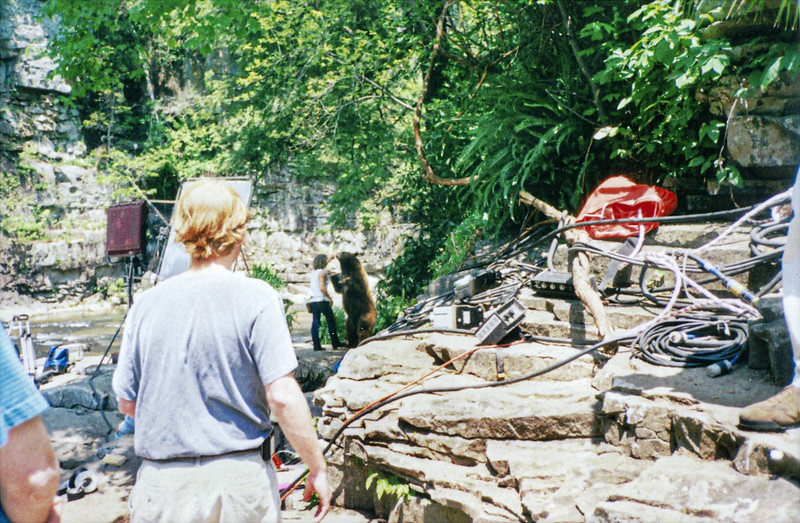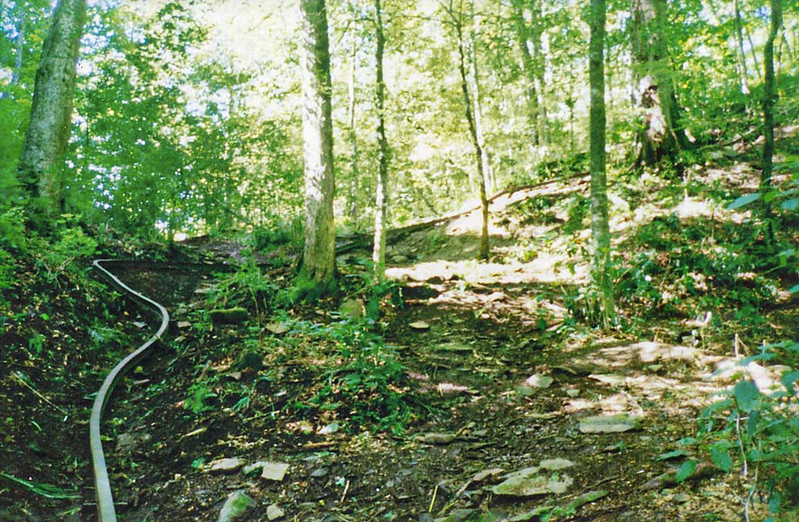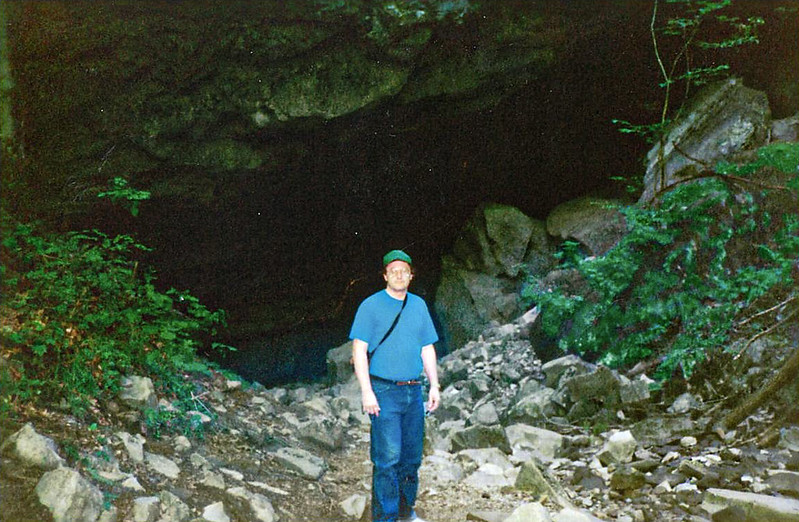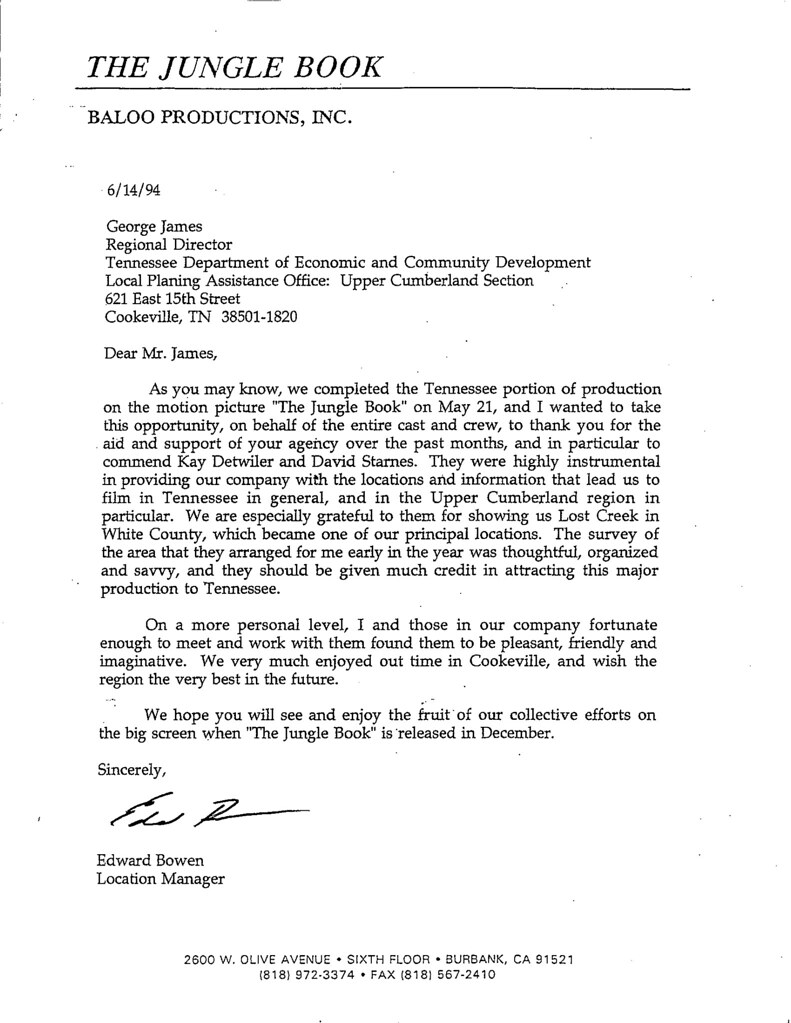Jungle Book Film (1994) and the Upper Cumberland
Table of Contents
The Story
|
THE STORY BEHIND WALT DISNEY'S DECISION TO FILM RUDYARD KIPLING'S JUNGLE
BOOK MOVIE AT LOST CREEK CAVE AND WATERFALL
A PERSONAL RECOLLECTION BY DAVID STARNES RETIRED PRINCIPAL PLANNER LOCAL
PLANNING ASSISTANCE OFFICE TENNESSEE DEPARTMENT OF ECONOMIC AND COMMUNITY
DEVELOPMENT

|
Around 1991, Dancy Jones, the Tennessee Film Commission Director at that time, came to our office and explained the importance of the community planners and film commission as a state agency. She concluded her interesting talk in about an hour, and when she was ready to leave, someone in my office mentioned that if she ever needed a cave location for a movie, she should contact me. She wrote my name down and said her department would contact me if that were the case. I gave her my name and said I would help, but I thought I would never hear from her again, or her department for that matter.
I was an active caver in the 1960s through the 1980s, but there are still cavers in Tennessee who participated in this adventure sport more than I have. At 65, I consider myself retired from the sport, although I like to keep up with current caving such as new caving discoveries and for my data research. During my undergraduate at Tennessee Tech, I majored in geography with minors in geology and history. I was also a member of the local caving club, the Upper Cumberland Grotto (UCG), and the Tennessee Cave Survey (TCS). My interest in the TCS is the cave data pertaining to the geographic location of caves, specifically rock strata and physiographic provinces in Tennessee. Through T.C. Barr’s Caves of Tennessee, I, like many cavers at the time,was intimately familiar with the notable caves in the state, such as Lost Creek. For years, cavers considered this book a Bible for Tennessee Caves.
In the mid-1970s, I visited Lost Creek Cave for the first time with the late Art Bosnak, a well-known local caver who photographed cave formations. Some cavers, in a light-hearted way, thought Art was not suited for caving, especially in caves with tight constrictions, withArt being almost seven feet tall- probably the tallest basketball player to ever play for Tennessee Tech. Professionally, Art was a rural school teacher; however, he also had an academic background in biology. He sampled water in caves to determine the water quality's impact on cave life and published at least one professional paper on this topic.On this first trip to Lost Creek, Art and I were going for water samples.
We first stopped to visit his friend in Sparta, Ross Cardwell. Ross did not cave that day, but cautioned us about rattlesnakes and copperheads being in the sink on such a warm day. After arriving at the sink, we accessed the cave by parking on the sink's north side, which is no longer used because of the larger developed parking area on the southern side of the sink. On our trip back into the cave, we went as far as the 40-foot underground waterfall, a well-known feature. Art retrieved water samples from Lost Creek that day and samples at the entrance of nearby Merrybranch Cave, although we did not explore this one.
To my surprise, in late 1993 or early 1994, the Tennessee Film Commissioncontacted me through the Local Planning Assistance Office. A movie company filming in Tennessee needed a cave entrance in the Cookeville area that could be used for the positioning of wolves. The movie company, Walt Disney, was filmingThe Jungle Book,released in December 1994.The location manager for the movie was Edward Bowen, or “Eddie” as we called him, and he was coming to Cookeville so I could take him to a cave that could be used in the movie. I was known to have knowledge of area caves, so they thought I would help find them a cave. I knew exactly what they were looking for: a cave to have an entrance that (1) they could position wolves for a young boy (Mowgli) to encounter after becoming lost in the jungle; (2) did not have cave formations, as these could be a distraction; (3) has a relatively level floor for cameras; and (4) could be readily accessed from a nearby road and be fairly easy to walk to with the movie equipment.
Eddie arrived at the Local Planning Assistance Office and I explained I knew of two caves in the area that might fit their purpose. One was Kuykendall Cave, in Putnam County, which we visited first, it being less than five miles north of the planning office on East 15th Street. The second was Lost Creek, which was much further out, in a rural area of southeastern White County. Both caves were generally described to him, and we would visit the smaller Kuykendall Cave in the morning, and then the much larger, remote Lost Creek Cave in the afternoon.
Joining on the the trip to the caves was an assistant from the Tennessee Film Commission and Kay Detwiler another staff planner at LPAO. Kay was helpful to the film company in the local logistics of having a base of operation in the Cookeville area.
After arriving at Kuykendall Cave, located about 100 yards east of Free Hill Road on the northern edge of Cookeville, we proceeded into the cave with flashlights. Eddie Bowen took several photos inside the cave of a sizable room, as well as the entrance itself. Although it might be useful for a minor shooting location, as opposed to a principal location site, I think Eddie's opinion was that he would like to see the Lost Creek Cave, in order to see if its larger cave entrance could better accommodate a film crew. Kuykendall's location and accessibility to Free Hill Road were good, but the twenty-foot wide but only seven-foot high entrance could be restrictive in getting movie cameras into the cave. In addition, ledges suitable for positioning the wolves seemed to be few and too small.
After Kuykendall Cave, we had lunch at a now defunct steakhouse, Quincy’s on South Jefferson Avenue in Cookeville. During lunch, Eddie mentioned we could not talk to anyone about a film company coming to the area to make a movie. Any leak out may make Disney move to another location. Eddie also planned Fall Creek Falls State Park as a principal location. Since he earned fame for his Oscar nomination “Silence of the Lambs”, Eddie told us Disney was trying to get Anthony Hopkins to be in the movie, either as Colonel Geoffrey Brydon (Kitty's father), or the physician Dr. Julius Plumford. This fell through and Sam Neil or John Cleese took the role meant for him.
On the drive to Lost Creek Cave, I told Eddie that "Lost Creek Cave, as well as having a large entrance, is situated in a large sink, with a 60-foot waterfall that is considered to be quite scenic". He politely but firmly responded, "well, we are not interested in any waterfalls or the sinkhole itself, just a cave entrance to position wolves for a filming shot". I responded by saying, "okay, and I do hope this large cave entrance could be what you are looking for". We arrived at the small, gravel parking area on the north side of the sink. A major ice storm hit this part of the state a few days after our visit, so if we had not visited when we did, we likely would not have been able to.The storm caused considerable damage in the Upper Cumberland including downed power lines and road closures due to fallen trees.
Eddie took photos of the steep walls on the walk into the sink and of the large cave entrance on our left. Unfortunately, someone parked directly above the cave and threw a dead goat, which was now lying at the entrance on a rock slab. We Walked to the 60-foot waterfall where Eddie took more photos. It was a dreary, overcast day and the green foliage that covers the sink in spring and summer was notably absent, leaving this karst feature with a brownish-grayish appearance. Fortunately, the lack of foliage allowed us to see how big the sink was. Since Eddie was obviously photographing features other than the cave entrance, I approached him to ask what he thought about this place. Eddie let us know he was impressed with Lost Creek Sink, not only the large cave entrance, but also the 60-foot waterfall and the sink itself. He was so impressed he was to meet with the movie director, Stephen Sommers,who was flying into Atlanta from India, after likely filming there. Eddie was going to try to convince Sommers to rewrite the script to accommodate, what he thought, was a very beautiful and exotic place.When we returned to the planning office, Eddie thanked us for a great tour of the area.
At the Atlanta meeting, the men decided that what was supposed to be a minor would now be a principal location. In the script rewrite, the wolves that were supposed to be in a cave entrance, were relocated to the grotto-like base of the Lost Creek Waterfall. They built a monorail on the south-side of the steep sink slope for Mowgli to slide in down into a dark and scary forest. The Lost Creek Cave only appeared at the end of the movie when Mowgli and Kitty are fleeing Monkey City. As they leave the dark cave into sunlight, they immediately have a dramatic confrontation with Shere Khan the Tiger. At the end, Disney used the waterfall as a backdrop for a romantic scene between Mowgli and Kitty and the credit’s backdrop. It is likely more movie scenes involve Lost Creek Sink, but these are the most prominent.
Disney likely secured the right to film in Lost Creek through longtime owner, James Rylander, since at the time it was not a state natural area. According to Larry Matthews's book, Caves of Fall Creek Falls, Rylander deeded the cave and surrounding property to the state as a part of Fall Creek Falls State Park. I believe this took place sometime around 2004, but the state website says that it was designated a state natural area in 2012. Fall Creek Falls State Park, not far from Lost Creek, may have influenced Disney to consider it as a principal location. Fall Creek Falls seemed to serve as a primary base of field operations for the filming in the area. Several scenes in the movie were filmed at the state park. These include the crossing at the top of Fall Creek Falls by Captain William Boone and his men on the way to Monkey City, and the dramatic jump of Mowgli off a high cliff into the large pool at the base of Cane Creek Falls. There were also scenes involving the swinging bridge over Cane Creek Cascades and the gorge area downstream of the cascades.
Filming started in a few weeks, especially at Fall Creek Falls State Park. Along with some dignitaries that included local and state officials, Kay and I were invited to the state park for half-a-day to see filming and to have lunch. After arriving and unsure of where to go, we by chance asked a man where we were expected. Of all people, it was the producer, Edward S. Feldman himself, a very nice and down-to-earth individual. He told us to head on down to the Cane Creek Nature Center where other guests were meeting (Photos 1 and 2). At the center, a group was led into the Cane Creek gorge where a for a filming of a movie scene involving Baloo the Bear (Photos 3 and 4).
Following the shoot, we went to the parking lot, where the tiger from the movie was kept in an open grassy area nearby. Park visitors were not allowed near the animal and it was fenced off by yellow ribbons around trees. A movie assistant walked the lion around and tended to its needs (Photo 5). Kay and I drove a short distance to a large red/white tent that was set up for lunch (Photo 6). The catered lunch was excellent and the movie producer, Edward Feldman sat to my right telling us how niceTennesseans were and how the state park personnel were helpful in their filming. Following lunch, our VIP tour was over and we headed back to the Local Planning Office in Cookeville.
A short time later, Kay and I had supper at Applebee’s in Cookeville with Eddie, where he again thanked us for our help. Our conversation about filming gave me the impression that the monorail didn't really prove that useful. There are only a few seconds in the movie involving it and it was at night when the movie viewer couldn't really see what was going on. I inquired if the crew saw any snakes, especially the poisonous types. He looked at me, rolled his eyes, and muttered something like "oh man!" I took this to mean that they probably had at least one snake encounter while being there.
Although work at the Local Planning Assistance Office is rarely routine, it can be mundane with reviewing subdivision plats, zoning issues, and preparing land use studies and grant applications, etc. I was grateful that the Tennessee Film Commission contacted and involved me in the making of Walt Disney's “The Jungle Book”. It was a once in a lifetime opportunity. Tennessee has many exotic and reasonably accessible locations for movie crews. I hope movie companies will continue taking advantage of the beautiful natural settings in our state, as well as urban settings that can be found in our major cities such as Nashville, Memphis, Knoxville and Chattanooga.
David Starnes's Photos

Local dignitaries waiting to walk down into the Cane Creek gorge to see the filming of a bear scene for The Jungle Book movie.

Left to right, David Starnes, Doug McBroom (former county executive of Putnam County), and former state representative Jere Hargrove. Remainder are film crew personnel standing around waiting for the movie scene involving the bear to be set up and filmed.

Film crew personnel standing around waiting for the movie scene involving the bear scene to be set up and filmed

Filming of the bear scene with the bear visible near the middle of the photo. A trainer appears to be giving the bear a treat to make it rise up.

A trainer walking the tiger (in the middle of the photo) in the parking lot at the Cane Creek Nature Center.

Film crew location site that was set up in the park south of the nature center. Large red and white tent is where catered lunch was served.

Another photo of monorail. According to the location manager, this apparatus may not have been used as much as expected by the film crew.

David Starnes standing in front of the entrance to Lost Creek Cave.

Letter From Location Manager
April Moore's Photos





The Junglebook Watch Guide for Locals
Rudyard Kipling’s Jungle Book on Amazon Prime Video
Below is a watch guide for Disney’s 1994 live action Jungle Book movie. If you know the Upper Cumberland region, you’ll recognize these iconic locations!
| Time | Location | Screenshot |
| 0:15:50 | Lost Creek Falls |  |
| 0:16:27 | Lost Creek Falls |  |
| 0:26:16 | Cane Creek Cascades |  |
| 0:28:56 | Fall Creek Falls |  |
| 0:30:50 | Cane Creek |  |
| 1:18:42 | Fall Creek Falls |  |
| 1:27:32 | Cane Creek Falls |  |
| 1:27:36 | Buzzards Roost |  |
| 1:27:48 | Lost Creek Falls |  |
| 1:27:53 | Cane Creek Gorge |  |
| 1:28:25 | Cane Creek Falls - unsure |  |
| 1:29:42 | Cane Creek Cascades jump |  |
| 1:29:44 | Cane Creek Falls jump |  |
| 1:43:07 | Lost Creek Cave |  |
| 1:44:07 | Lost Creek Cave |  |
| 1:46:05 | Lost Creek Falls |  |
Comments